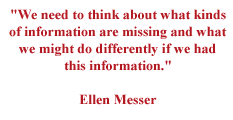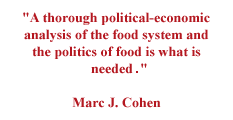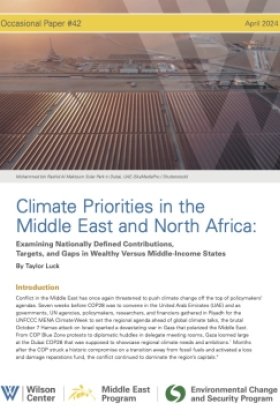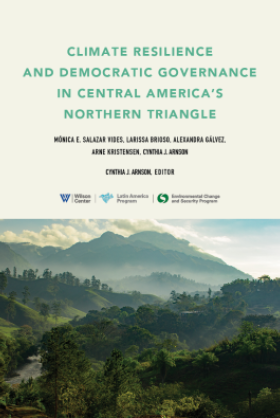Conflict: A Cause and Effect of Hunger
Overview
Featuring Ellen Messer, Visiting Associate Professor, School of Nutrition Science and Policy, Tufts University;
Marc J. Cohen, Special Assistant to the Director General, International Food Policy Research Institute (IFPRI);
and Emmy Simmons, Special Advisor to the Assistant Administrator of the Global Bureau, U.S. Agency for International Development (discussant)
Co-Sponsored by the Woodrow Wilson Center's Conflict Prevention Project
October 30, 2001—Areas of famine are almost exclusively found in areas of armed conflict, and food wars—the use of hunger as a weapon in active conflict and the consequential food insecurity—left close to 24 million people in 1999 hungry and in need of humanitarian assistance. Saying that policymakers need to find ways to more closely marry conflict prevention and agricultural and development aid, Tufts University professor and former Wilson Center Fellow Ellen Messer and Marc J. Cohen of the International Food Policy Research Institute presented and discussed their new Environmental Change and Security Project Report article, "Conflict: A Cause and Effect of Hunger." Emmy Simmons of USAID served as discussant.
Food and Conflict: Close Connections
 Ellen Messer opened by saying that the authors' ongoing project (which has been joined at times and for the current article by Thomas Marchione of USAID) has moved from (a) writing about the history of hunger to (b) looking at where famine and conflict persist in the modern world, and then to (c) examining how hunger has been used as a weapon. Currently, the team is studying the history of agricultural development in conflict and post-conflict zones as well as how conflict prevention can be worked into programs of peaceful and conflict-zone development projects. "There is great complexity that goes into questions of conflict as well as food security," said Messer. "We need to think about what kinds of information are missing and what we might do differently if we had this information."
Ellen Messer opened by saying that the authors' ongoing project (which has been joined at times and for the current article by Thomas Marchione of USAID) has moved from (a) writing about the history of hunger to (b) looking at where famine and conflict persist in the modern world, and then to (c) examining how hunger has been used as a weapon. Currently, the team is studying the history of agricultural development in conflict and post-conflict zones as well as how conflict prevention can be worked into programs of peaceful and conflict-zone development projects. "There is great complexity that goes into questions of conflict as well as food security," said Messer. "We need to think about what kinds of information are missing and what we might do differently if we had this information."
 As an example of the close connection between food and conflict, Messer cited plunging coffee prices as an integral part of the Rwandan genocide of the mid-1990s; low crop prices made Rwandans feel that they had no future and "made them all the more ripe for exploitation and mobilization by unscrupulous leaders," she said. Can a similar situation be avoided in Colombia, Messer asked, which is also beset by plummeting coffee prices? Another area of concern is how to deliver food aid in ways that do not exacerbate rising tensions and intergroup competition over resources. Messer said that the selective way in which Rwandan food aid was distributed, for instance, added to the tension there.
As an example of the close connection between food and conflict, Messer cited plunging coffee prices as an integral part of the Rwandan genocide of the mid-1990s; low crop prices made Rwandans feel that they had no future and "made them all the more ripe for exploitation and mobilization by unscrupulous leaders," she said. Can a similar situation be avoided in Colombia, Messer asked, which is also beset by plummeting coffee prices? Another area of concern is how to deliver food aid in ways that do not exacerbate rising tensions and intergroup competition over resources. Messer said that the selective way in which Rwandan food aid was distributed, for instance, added to the tension there.
Messer also outlined a series of goals that the authors' research has highlighted for conflict and hunger prevention:
* Use mapping (now being done to identify areas of acute food shortages) to identify priority areas for conflict prevention and agricultural development;
* Study how conflict prevention can be built into development aid and how food relief might be used to avert conflict;
* Avoid macro models that predict conflict with just a few indicators (such as infant mortality rates) in favor of nuanced analyses of particular situations of peace and conflict;
* Study how women could be integrated into central agricultural decision-making and how the participation of women could lead to more peaceful instead of conflictual outcomes;
* Convince development and relief professionals to work together and share a common vision for peaceful development that can also prevent conflict;
* Increase general development aid, especially to Africa and to agriculture.
Causality and Controversy
Marc Cohen next outlined the major findings of "Conflict: A Cause and Effect of Hunger." He began by noting that both armed conflicts and people needing humanitarian assistance in 1999 were overwhelmingly concentrated in sub-Saharan Africa and parts of Asia. "Not coincidentally," he said, "these are areas of the world that are the center of gravity of food and security."
 Hunger as a consequence of conflict is easily understood, Cohen said: conflict in a poor area destroys crops, deploys landmines that injure people and make it unsafe to farm, and produces refugees and crowded camps that increase susceptibility to disease. In 13 of 14 countries in conflict in Africa from 1970-1994, Cohen said, food production declined by a mean of 12.3 percent in years of conflict. Conflict also causes further food insecurity by interrupting or in many cases ending schooling for children. Cohen cited an IFPRI study that found female education and food availability as the two largest factors in reducing child malnutrition from 1970-95. In addition, Cohen noted that, in sub-Saharan African countries experiencing conflict, losses in agricultural production because of conflict were equivalent to a very high percentage of aid these countries were receiving and vastly exceeded the level of foreign direct investment in them.
Hunger as a consequence of conflict is easily understood, Cohen said: conflict in a poor area destroys crops, deploys landmines that injure people and make it unsafe to farm, and produces refugees and crowded camps that increase susceptibility to disease. In 13 of 14 countries in conflict in Africa from 1970-1994, Cohen said, food production declined by a mean of 12.3 percent in years of conflict. Conflict also causes further food insecurity by interrupting or in many cases ending schooling for children. Cohen cited an IFPRI study that found female education and food availability as the two largest factors in reducing child malnutrition from 1970-95. In addition, Cohen noted that, in sub-Saharan African countries experiencing conflict, losses in agricultural production because of conflict were equivalent to a very high percentage of aid these countries were receiving and vastly exceeded the level of foreign direct investment in them.
 However, food insecurity as a cause of conflict is more controversial. Cohen sketched out the argument between the environmental security school and the more traditional conflict/peace studies school over whether environmental scarcities (of which food insecurity is a prime example) can be major causes of conflict. Cohen and Messer believe that food insecurity or environmental scarcity is not alone sufficient to trigger conflict, but that other factors (such as human rights violations, oppressive social inequalities, and—most importantly—cultural values that legitimate violent resistance) are necessary. "We would also argue that a thorough political-economic analysis of the food system and the politics of food is what is needed," said Cohen.
However, food insecurity as a cause of conflict is more controversial. Cohen sketched out the argument between the environmental security school and the more traditional conflict/peace studies school over whether environmental scarcities (of which food insecurity is a prime example) can be major causes of conflict. Cohen and Messer believe that food insecurity or environmental scarcity is not alone sufficient to trigger conflict, but that other factors (such as human rights violations, oppressive social inequalities, and—most importantly—cultural values that legitimate violent resistance) are necessary. "We would also argue that a thorough political-economic analysis of the food system and the politics of food is what is needed," said Cohen.
He added that a human rights perspective is critical to any effective food security initiative—not only emphasizing the long-affirmed right not to starve, but also a more broadly-conceived human rights framework for analysis, planning, and evaluation of development programs.
An Institutional Perspective
Discussant Emmy Simmons welcomed "Conflict: A Cause and Effect of Hunger" and its emphases on linking relief to development, looking to civil society participation, and emphasizing conflict avoidance rather than simply addressing ongoing conflict. "Working for AID," Simmons said, "one is struck by the number of situations that one is dealing with in which conflict seems just around the corner or is in full swing or in which the AID program is being put on the ground in order to resolve a conflict and move a country toward recovery."
However, Simmons said that agencies like AID don't implement the kind of recommendations made in "Conflict: A Cause and Effect of Hunger" either very systematically or very well. She stressed that AID, other donor agencies, and NGO partners are action-oriented. "In bad or deteriorating or needy situations, we say—'OK, let's do something.'" said Simmons. "We get on the ground and we try to figure out what is useful." Such a climate, Simmons suggested, is not receptive to Messer's suggestion, for example, that agricultural development might actually trigger conflict in some situations instead of alleviating it.
 Simmons made several points about development assistance as practiced by the West. First, she stressed the lack of fungibility between different pools of resources in an agency such as AID, which hampers flexibility in responding to changing situations. Second, development needs today far exceed the availability of AID resources. Simmons noted that, while OECD countries provide $360 billion in subsidies to their own agricultural industries, they offer only $53-55 billion in overseas development assistance, with less than 1/1000 of the $360 billion figure invested in international agricultural research. "This requires us to be much more strategic," she said, "much more tactical, to try to figure out where it is we need to prioritize and make the most difference."
Simmons made several points about development assistance as practiced by the West. First, she stressed the lack of fungibility between different pools of resources in an agency such as AID, which hampers flexibility in responding to changing situations. Second, development needs today far exceed the availability of AID resources. Simmons noted that, while OECD countries provide $360 billion in subsidies to their own agricultural industries, they offer only $53-55 billion in overseas development assistance, with less than 1/1000 of the $360 billion figure invested in international agricultural research. "This requires us to be much more strategic," she said, "much more tactical, to try to figure out where it is we need to prioritize and make the most difference."
Third, Simmons said, people who work in the development assistance business are highly specialized and competitive, with skills that might not transfer well into programs with other objectives. "The call we have here for a much more integrated, much more multi-scale approach kind of intervention in terms of conflict recovery and prevention is a very difficult one to pull off in terms of putting people on teams," said Simmons.
Yet Simmons stressed that, in coping with a rising trend of intrastate conflict (particularly in Africa and perhaps in Central Asia) as well as projected increases in global hunger by 2015, donors such as AID need to learn how to undertake precisely this kind of collective action. "We need to know how to bring together different kinds of resources—money, food, in-kind resources, intellectual, people—in a much more flexible and focused kind of way," Simmons said. She noted that the new reorganization of USAID potentially sets relief and humanitarian assistance efforts against long-term development in a competition for resources. "I want to thank our speakers here for kicking us off in thinking about this as a really serious issue that collectively we have to address," she said.
Glossary
Environmental security school: Some researchers argue that environmental issues are also national security issues—that problems such as climate change, infectious diseases, and resource scarcity can contribute to national and international insecurity. For example, an infectious disease (such as HIV/AIDS) that kills a substantial portion of the population (as is now occurring in sub-Saharan African countries) affects national security in several ways: (1) the military may lose a large number of officers and soldiers to the disease; (2) loss of workers to the disease may have a devastating impact on the national economy; (3) the treatment costs may prove unbearable for a weak health care infrastructure, leading to its complete breakdown; and (4) an inequitable distribution of much-needed medicines and other supplies may exacerbate existing civil tensions.
Hosted By

Environmental Change and Security Program
The Environmental Change and Security Program (ECSP) explores the connections between environmental change, health, and population dynamics and their links to conflict, human insecurity, and foreign policy. Read more
Thank you for your interest in this event. Please send any feedback or questions to our Events staff.










